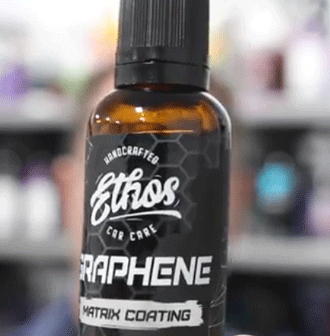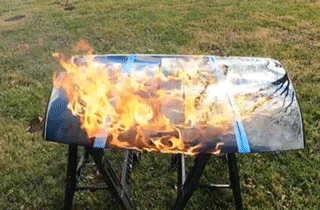I’m not one to throw money at every car care product that promises a showroom shine, but Chemical Guys Carbon Force Ceramic Coating? It’s the real deal. This stuff transforms your ride into a glossy, water-repelling beast that laughs off dirt and grime. I’ve coated my SUV with it, and the results blew me away—think mirror-like finish and protection that lasts years, not months. If you’re serious about keeping your car looking pristine, grab this now. Let’s dive into my experience and why it’s worth every cent.
My Journey With Chemical Guys Carbon Force

Picture this: my 2019 Honda Pilot, battle-scarred from years of road trips, kid spills, and parking lot dings, was looking… tired. The paint had lost its pop, and washing it felt like a losing battle against water spots and swirl marks. I’d heard the hype about ceramic coatings—long-lasting protection, insane shine—but I wasn’t ready to drop hundreds at a pro shop. Enter Chemical Guys Carbon Force. It promised professional-grade results for a DIYer like me, so I thought, why not? Worst case, I’d waste a Saturday afternoon.
Spoiler alert: it wasn’t a waste. Applying Carbon Force was a project—prep, polish, coat, wait—but the payoff was unreal. My Pilot’s paint went from dull to dazzling, with a deep gloss that made it look like it just rolled off the lot. Water beads up and rolls off like magic, and dirt? It barely sticks. I’ve been using it for six months now, and it’s still going strong. Sure, it’s not perfect (nothing is), but let me walk you through what makes it awesome, where it falls short, and how to make it work for you.
The Pros Of Chemical Guys Carbon Force
Carbon Force isn’t just another shiny bottle on the shelf—it’s a beast when it comes to protecting your car. Here’s why I’m hooked:
Also Read: My Thought on Sky Organics Organic Castor Oil Review
- Insane Gloss: This coating gives your paint a deep, wet-look shine that screams luxury. My Pilot looks like it’s been waxed to perfection, but better.
- Hydrophobic Magic: Water beads up and slides off like it’s allergic to your car. Rainy days? Your ride stays cleaner longer.
- Long-Lasting Protection: They claim up to five years, and while I’m not there yet, six months in, it’s still flawless. No fading, no peeling.
- Scratch Resistance: It’s not bulletproof, but light swirls and scratches don’t stand a chance. My car’s paint feels tougher already.
- Easy Maintenance: Dirt and grime don’t cling like they used to. A quick rinse, and my SUV looks spotless—saves me tons of time.
- UV Protection: The coating blocks harmful rays, keeping your paint from oxidizing. My black paint hasn’t faded a bit.
- Layering Option: You can stack multiple coats for extra thickness. I did two layers, and the depth is unreal.
- DIY-Friendly: Clear instructions make it approachable, even if you’re not a pro. I had no issues as a first-timer.
- Versatile Application: Works on paint, glass, wheels—even plastic trim. I coated my headlights, and they’re crystal clear.
- Professional-Grade Results: For a fraction of a shop’s price, you get a finish that rivals what the pros charge thousands for.
Each of these perks makes Carbon Force a winner. The gloss hooked me first—every time I park, I catch myself staring. The hydrophobic effect is like a science experiment; I’ve had neighbors ask what wizardry I’m using. And knowing my paint’s protected from UV rays and scratches gives me peace of mind, especially with how rough my commute can be. If you love your car, this coating’s a no-brainer.
The Cons Of Chemical Guys Carbon Force
Let’s keep it real—Carbon Force isn’t flawless. I ran into a few headaches that might bug you too. Here’s the scoop:

- Pricey Upfront: At around $140, it’s not cheap for a DIY product. I hesitated, wondering if a wax would do the trick for less.
- Prep Work Is Intense: You need a clean, polished surface, or it’s game over. I spent hours washing, claying, and polishing—exhausting.
- Application Time: Coating my SUV took a full day, including curing time. If you’re impatient, this isn’t a quick fix.
- Tricky in Heat: Apply in a cool, shaded area, or it flashes too fast. I almost messed up a panel when the sun hit it.
- Streaking Risk: If you’re sloppy or don’t buff properly, you’ll see streaks. I had to redo a section—annoying.
- Gloves Required: The chemicals are no joke—goggles and gloves are a must. I felt like a mad scientist, which isn’t everyone’s vibe.
- Not Scratch-Proof: It resists light scratches, but don’t expect miracles. A rogue shopping cart still left a mark.
- Reapplication Limits: Once it’s on, you can’t just slap more on easily. You’ll need to polish it off first, which is a pain.
- Learning Curve: First-timers might stress about getting it right. I watched a ton of YouTube videos to avoid screwing up.
- Bottle Size: For a big vehicle, one bottle feels tight. I barely had enough for two coats on my Pilot.
These downsides don’t ruin the deal, but they’re worth knowing. The prep work nearly broke me—I underestimated how much elbow grease it’d take. And the price stung until I saw the results. If you’re ready to commit, it’s worth it, but don’t expect a magic wand you can wave and be done.
Maintenance And Tips To Get The Most Out Of Carbon Force
To keep your Carbon Force coating looking fresh, you’ve got to treat it right. Here’s how I’ve learned to maximize its performance:
- Prep Like a Pro: Wash, clay bar, and polish your car before applying. I skipped polishing one panel, and the coating didn’t bond as well.
- Work in Small Sections: Coat one panel at a time—about 3×3 feet. It’s easier to control, and I avoided streaks this way.
- Use Quality Applicators: The included pads are fine, but I grabbed extra microfiber suede cloths for smoother application.
- Buff Thoroughly: After 3-4 minutes, wipe off with a clean microfiber towel. I missed a spot once, and it was a pain to fix.
- Cure Properly: Let it sit for 24 hours without water or rain. I parked in my garage to be safe—worth the wait.
- Wash Gently: Use a pH-neutral soap and two-bucket method. Harsh chemicals or scrub brushes can dull the coating.
- Top with Boost Spray: Chemical Guys’ HydroCharge spray adds extra slickness. I use it monthly, and it keeps the beads tight.
- Avoid Abrasives: No gritty sponges or automatic car washes. I stick to foam cannons and mitts to keep it pristine.
- Reapply Annually (Optional): A single layer every year can refresh it. I’m planning to try this to stretch the life.
- Store Smart: Keep the bottle in a cool, dry place. Mine’s in a cabinet to avoid leaks or spoilage.
These tips have been my lifesaver. Prepping properly was half the battle—don’t cut corners, or you’ll regret it. Gentle washing keeps the coating happy, and that boost spray? It’s like giving your car a shot of espresso. Follow this routine, and your ride will stay glossy for years.
Chemical Guys Carbon Force Vs. Other Brands
I’ve dabbled with other coatings and waxes, so how does Carbon Force stack up? Let’s compare it to some heavy hitters.

Carbon Force vs. Adam’s Graphene Ceramic Coating
- Durability: Carbon Force claims five years; Adam’s says up to seven. I’ve only tested Carbon Force, but it’s holding strong.
- Application: Carbon Force is gel-like and forgiving; Adam’s is syrupy and needs precision. I’d pick Carbon Force for ease.
- Gloss: Both deliver deep shine, but Carbon Force’s wet look feels bolder to me. Adam’s is more subtle.
- Hydrophobicity: Carbon Force beads tighter; Adam’s spreads water more evenly. I love watching Carbon Force repel rain.
- Price: Carbon Force is pricier ($140 vs. $100). Adam’s feels like a better deal for budget-conscious folks.
- Prep: Both demand heavy prep, but Adam’s includes a surface-prep spray, which Carbon Force lacks.
- Scratch Resistance: Carbon Force edges out slightly for light scratches. Adam’s feels a touch softer.
- Versatility: Carbon Force works on more surfaces (glass, wheels); Adam’s is pickier about plastic trim.
- Cure Time: Carbon Force needs 24 hours; Adam’s takes 48. I liked getting back on the road faster.
- Brand Trust: Both are solid, but Chemical Guys’ DIY focus resonates more with me than Adam’s.
Carbon Force vs. Turtle Wax Hybrid Solutions Ceramic Spray
- Longevity: Carbon Force lasts years; Turtle Wax is good for months. No contest for long-term protection.
- Ease of Use: Turtle Wax sprays on like a detailer—super easy. Carbon Force is a project by comparison.
- Shine: Carbon Force’s gloss is deeper; Turtle Wax looks great but lacks that “wow” depth.
- Cost: Turtle Wax is dirt cheap ($20 vs. $140). If you’re not ready to commit, it’s a solid starter.
- Hydrophobicity: Carbon Force beads better; Turtle Wax’s water-repelling fades faster, in my experience.
- Prep Needs: Carbon Force requires polishing; Turtle Wax just needs a clean surface. Less hassle.
- Scratch Protection: Carbon Force is tougher; Turtle Wax barely fights swirls. Carbon Force wins here.
- Maintenance: Turtle Wax needs reapplying often; Carbon Force is low-maintenance for years.
- Application Time: Turtle Wax takes 10 minutes; Carbon Force is an all-day affair. Pick your poison.
- Results: Carbon Force feels pro-grade; Turtle Wax is consumer-friendly but doesn’t match the quality.
Carbon Force vs. Gtechniq CSL
- Durability: Gtechniq claims seven years; Carbon Force says five. Both seem solid, but Gtechniq might edge out.
Also Read: My Thought on Sky Organics Organic Castor Oil Review
- Application: Gtechniq is finicky—needs perfect conditions. Carbon Force is more forgiving for DIYers like me.
- Gloss: Carbon Force’s shine pops more; Gtechniq’s finish is sleek but less dramatic.
- Price: Gtechniq is pro-priced ($200+); Carbon Force is a steal by comparison, even at $140.
- Hydrophobicity: Both bead like crazy, but Carbon Force feels slicker when wiping down.
- Prep: Gtechniq demands surgical cleanliness; Carbon Force is picky but not insane.
- Scratch Resistance: Gtechniq might be tougher, but Carbon Force handles daily wear just fine.
- Availability: Carbon Force is at every retailer; Gtechniq’s harder to find without ordering online.
- Cure Time: Gtechniq takes longer (48 hours); Carbon Force is ready in 24—big win for me.
- DIY Appeal: Carbon Force is made for hobbyists; Gtechniq feels like it’s for pros with fancy garages.
Carbon Force holds its own, especially for DIYers. Adam’s is a close rival for value, Turtle Wax is great for quick jobs, and Gtechniq is the premium pick—but Carbon Force balances cost, ease, and results better than most.
Frequently Asked Questions (Faq)
It’s great for paint, glass, and wheels, but test on plastic trim first. I had no issues on my headlights, but a buddy got haze on uncoated plastic—yikes.
One good application can last years—mine’s still going at six months. You can add a layer annually if you want, but it’s not mandatory.
Nope, it’s not a polish. It hides light swirls but won’t fix deep scratches. I had to polish first to get my paint smooth.
Final Thought:
Six months in, and Chemical Guys Carbon Force has me sold. My SUV’s paint pops like never before, and maintenance is a breeze—water and dirt don’t stand a chance. Yeah, it’s a bit of work to apply, but the glossy, protected finish is worth every second. If you want your car to shine like it’s fresh from the factory, snag this coating. You’ll thank me when you’re admiring your reflection in the hood. Trust me, it’s a game-changer you won’t regret.
